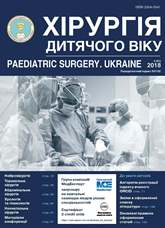Stabilization of the breast-ribble complex at the large flotting fractures of ribs in children: literature review and own experience
DOI:
https://doi.org/10.15574/PS.2018.61.25Keywords:
floating fractured ribs, chest stabilization, polytrauma in childrenAbstract
Thoracic injury is the leading cause of fatal complications. The incidence of chest trauma remains high. There are many fixation methods of the floating ribs of thoracic cage, which are technically challenging and linked to various materials.
Objective: to search options for the sternocostal complex stabilization without the expenditures for manufacturing customised devices; to describe and implement the rib cage fixation method for floating fractured ribs in severely injured children, which is used by paediatric surgeons in Tyumen.
Material and methods. In the south of the Tyumen Region for the period of 2016–2018, an original method of fixing the thoracic cage with multiple floating fractured ribs by means of a V-shaped modelled Cramer’s wire splint to extend the area of contact with the rib cage was used in four patients aged from 9 to 17 years. The splint was sutured with non-absorbable threads to the edges of stable parts of the ribs and to unstable segment of the rib cage, followed by its external fixation.
Results. Having applied this method, it was possible to reliably, minimally invasively stabilize the rib cage in patients, achieve early spontaneous breathing, which reduced the length of stay in the intensive care unit. No purulent septic complications were observed.
Conclusions. The proposed restoration method of skeletal function of the chest by using the external fixation with a V-shaped Cramer’s wire splint is simple and acceptable in any hospital.
References
Benyan AS. (2014). Primenenie etapnogo podhoda k stabilizatsii grudnoy kletki pri mnozhestvennyih i flotiruyuschih perelomah reber. Meditsinskaya nauka i obrazovanie Urala. 4: 60–63.
Vagner EA. (1981). Hirurgiya povrezhdeniy grudi. Moskva: Meditsina.
Vishnevskiy AA, Rudakov SS, Milanov NO. (2005). Hirurgiya grudnoy stenki: Rukovodstvo. Moskva: ID Vidar-M.
Pronskih AA. (2014). Operativnoe vosstanovlenie karkasnosti grudnoy kletki u patsienta s tyazheloy zakryitoy travmoy grudi pri politravme. Sluchay iz praktiki. Politravma. 2: 65-70.
Satyivaldaev MN, Akselrov MA. (2017). Ustroystvo dlya vneshney stabilizatsii grudnogo karkasa pri flotiruyuschih perelomah reber. Patent RF na izobretenie #174276. 6. Satyivaldaev MN, Akselrov MA. (2018). Vneshnyaya stabilizatsiya grudnogo karkasa u detey pri kompleksnom lechenii tyazheloy travmyi grudnoy kletki: opisanie klinicheskih sluchaev. Ortopediya, travmatologiya i vosstanovitelnaya hirurgiya detskogo vozrasta. 2: 73-78.
Fedorova VD, Emelyanova SI. (2005). Hirurgicheskie bolezni. Rukovodstvo. Moskva: MIA.
Tseymah EA, Bombizo VA, Gontarev IN. (2013). Miniinvazivnyie tehnologii v kompleksnom lechenii bolnyih politravmoy s dominiruyuschimi povrezhdeniyami grudi. Barnaul.
Athanassiadi K, Gerazounis M, Theakos N. (2004). Management of 150 flail chest injuries: analysis of risk factors affecting outcome. Eur J Cardiothorac Surg. 26(2): 373–376. https://doi.org/10.1016/j.ejcts.2004.04.011; PMid:15296899
Baumann J, Stieglitz P, Desmonts JM, Drutel P, Poyart C. (1967). Traitement des volets thoraciques. Ann Chir Thor Car. 6(1): 43–52.
Bloomer R, Willett K, Pallister I. (2004). The stove-in chest: a complex flail chest injury Injury. 35(5): 490–493. https://doi.org/10.1016/S0020-1383(03)00291-2
Davignon K, Kwo J, Bigatello LM. (2004). Pathophysiology and management of the flail chest. Minerva Anestesiol. 70(4): 193–199. PMid:15173695
Garzon A, Seltzer B, Karlson K. (1968). Physiopathology of crushed chest injuries. Ann Surg. 168(1): 128–136. https://doi.org/10.1097/00000658-196807000-00015; PMid:5673189 PMCid:PMC1387197
Ginsberg R, Kostin R. (1977). 5 New approaches to the management of flail chest. Can Med Assoc J. 116(6): 613–615. PMid:343895 PMCid:PMC1879189
Hagen K. (1945). Multiple rib fractures treated with a drinker respirator: a case report. JBJS Am. 27(2):330–334.
Heroy WW, Eggleston FC. (1951). A method of skeletal traction applied through the sternum in «steering wheel injuries of the chest.» Ann Surg. 133: 127. https://doi.org/10.1097/00000658-195101000-00016
Jones T, Richardson E. (1926). Traction on the sternum in the treatment of multiple fractured ribs. Surg Gynec Obstet. 42: 283.
Liman ST, Kuzucu A, Tastepe AI et al. (2003). Chest injury due to blunt trauma. Eur J Cardiothorac Surg. 23(3): 374–378. https://doi.org/10.1016/s1010-7940(02)00813-8
Relihan M, Litwin M. (1973). Morbidity and mortality associated with flail chest injury: a review of 85 cases. J Trauma. 13(8): 663–671. https://doi.org/10.1097/00005373-197308000-00001; PMid:4720987
Williams M. (1948). Severe crushing injury to the chest. Ann Surg. 128(5): 1006–1011. https://doi.org/10.1097/00000658-194811000-00020; PMid:17859239 PMCid:PMC1513899
Yang Y, Dong L, Wang J. (2010). Memory alloy embracing fixator in treatment of multiple fractured ribs and flail chest. World J Emerg Med. 1(3): 212–215. PMid:25214971 PMCid:PMC4129686
Downloads
Issue
Section
License
The policy of the Journal “PAEDIATRIC SURGERY. UKRAINE” is compatible with the vast majority of funders' of open access and self-archiving policies. The journal provides immediate open access route being convinced that everyone – not only scientists - can benefit from research results, and publishes articles exclusively under open access distribution, with a Creative Commons Attribution-Noncommercial 4.0 international license(СС BY-NC).
Authors transfer the copyright to the Journal “PAEDIATRIC SURGERY.UKRAINE” when the manuscript is accepted for publication. Authors declare that this manuscript has not been published nor is under simultaneous consideration for publication elsewhere. After publication, the articles become freely available on-line to the public.
Readers have the right to use, distribute, and reproduce articles in any medium, provided the articles and the journal are properly cited.
The use of published materials for commercial purposes is strongly prohibited.

